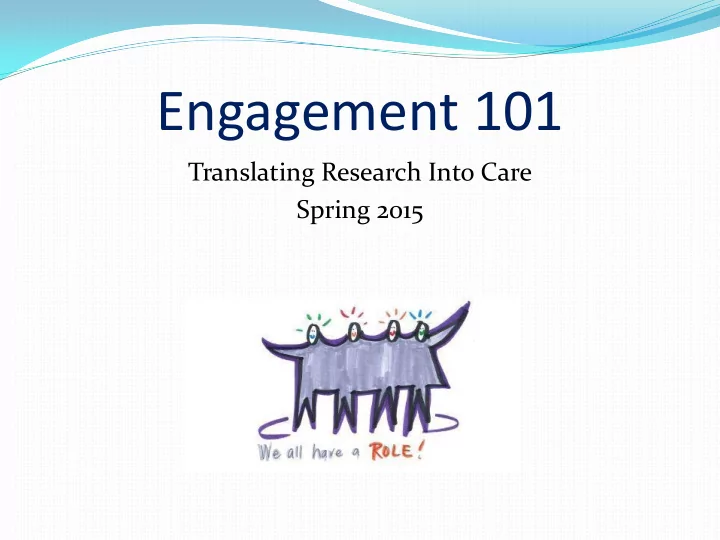

Engagement 101 Translating Research Into Care Spring 2015
Learning Outcomes Describe basic engagement theory Explain the IAP2 Spectrum of Public Participation Appreciate the planning process for engagement Identify readiness to engage Value patient/caregiver/stakeholder input
Agenda Background and context Foundations of engagement How to begin Words of wisdom Discussion-applying concepts
Background 2008 strategic priority at Capital Health 2010 engagement policy 2012 Patient and Public Engagement Team PPE team offers strategic advice, project support, training, communication, participant volunteer recruitment, evaluation, community relations, coordination and policy compliance
Context Patient and public engagement identified in new provincial health authority act. TRIC grant program requires inclusion of the patient voice in all applications. SPOR - The patient perspective is integrated into every step of the research process including developing research questions, defining research objectives, collecting data and evaluating results.
What is engagement? Creates sustainable trust based relationships by involving a wide range of interests and opinions in making decisions and setting priorities.
What is public participation? Any process that involves the public in problem solving or decision making and uses public input to make decisions. • Identify problems and opportunities • Developing alternatives • Decision-making
Engagement Theory Those affected by public decisions: • need accurate information , a voice , and the opportunity to participate in how decisions get implemented • will generally be more supportive , will seek ways to improve quality of decisions and their implementation • will be less likely to oppose them if they are given full information and their voices and concerns are heard and acknowledged
IAP2 Core Values A say in decisions that affect their lives Promises that the contribution will influence the decision Promotes sustainable decisions Seeks out and facilitates participation Seeks input in designing the participation process Provides information needed for meaningful participation Communicates back how input affected the decision
Values and Guiding Principles (SPOR) Patient engagement in research will improve the relevance of the research and improve its translation into policy and practice, contribute to more effective health services and products, and ultimately, improve the quality of life of Canadians and result in a strengthened Canadian health care system . Principles Description Patient engagement in research integrates a diversity of patient perspectives and is reflective of Inclusiveness their contribution – i.e., patients are bringing their lives into this. Adequate support and flexibility are provided to patient participants to ensure that they can Support contribute fully to discussions and decisions. This implies creating safe environments that promote honest interactions, cultural competence, training, and education. Researchers, practitioners and patients acknowledge and value each other’s expertise and Mutual Respect experiential knowledge. Patients, researchers and other SPOR stakeholders work together from the beginning to Co-Build identify problems and gaps, set priorities for research and work together to produce and implement solutions. Strategy for Patient-Oriented Research. Patient Engagement Framework – DRAFT – March 2014
CIHR of Citizens and Patients Listening/Informing Discussion Social Media Dialogue Town hall meetings Facebook Collaboration Research priority Café Scientifique setting workshops Twitter, YouTube Standing Committees Focus Groups Consensus Website resources Conferences Institute advisory boards Institute Working Groups Collaborative research methodologies Jeff Latimer, PhD . Director, Platforms and Major Initiatives, Research and Knowledge Translation Portfolio. Setting the Context, An overview of the Canadian Institutes of Health Research and the Strategy for Patient-Oriented Research Presentation at the CIHR Patient Engagement Workshop, January 9, 2014
Planning is doing!!!
Intention and Readiness Is there a decision to be What do you really want made? to know? Are there any Are you truly open to assumptions or non- considering different negotiables? perspectives? What is the decision? Can people contribute to the discussion? Who is the decision maker?
Intention and Readiness Have all potential Is the issue relevant to participants been the people you want to identified? engage? Have appropriate What information do resources been allocated they need to be able to (time, budget, people)? contribute in a meaningful way?
Practical Ideas Working with research funders to prioritise research. Offering advice as members of a project steering group. Commenting on and developing research materials. Collecting, analyzing, and/or disseminating project information and outcomes. Nicolas Fernandez, PhD nicolasfernandez@videotron.ca
Practical Suggestions Ensure Roles and Responsibilities are clearly understood. Weave research activities with teaching activities with patients and health professionals. Present at conferences in tandem. Let patients choose other patient research partners. Nicolas Fernandez, PhD nicolasfernandez@videotron.ca
Words of Wisdom Involve patients in Patient experience is knowledge translation. evidence. Patients can help assess Not a “one size fits all” the impact of research, the approach. “so what”. Benefits and challenges if Help identify key researchers are also messages, what’s patients. important to If patients become very patients/caregivers. savvy, they can adopt a researchers mindset and loose an outside perspective.
Challenge and Opportunity How will engagement change your work? What do you need to be able to engage patients/caregivers in your research?
Stay in touch Susan Dunn susan.dunn@nshealth.ca @engage4health
Recommend
More recommend